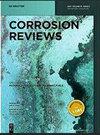Kinetics and mechanistic reaction pathway of carbon steel dissolution in simulated CO2–H2S medium in the presence of formic acid
IF 3.2
4区 材料科学
Q3 ELECTROCHEMISTRY
引用次数: 1
Abstract
Abstract Anodic dissolution of carbon steel in solution mixtures of simulated CO2–H2S in the presence of formic acid (0–500 ppm) was investigated using electrochemical methods such as potentiodynamic polarization and electrochemical impedance spectroscopy (EIS). The results show that the corrosion rate increases with an increase in the concentration of formic acid. Potentiodynamic polarization data revealed that the increase in cathodic current density plays a significant role in the increase of carbon steel corrosion rate. A combination of equivalent circuits was employed to model the impedance spectra of the carbon steel electrode acquired at open circuit potential and different overpotentials. The EIS data obtained at various overpotentials were further analyzed by reaction mechanism analysis (RMA) approach to interpret the dissolution mechanism. A multi-step reaction model including two dissolution paths and ferrous intermediate adsorbed species determined the dissolution behaviour of carbon steel. The best fit RMA kinetic parameters were retrieved using an optimization technique and the surface coverage of adsorbed species was estimated. Surface morphology of corroded steel surfaces was also examined with field emission scanning electron microscope demonstrating aggressive uniform corrosion of carbon steel in the presence of formic acid.甲酸存在下碳钢在模拟CO2-H2S介质中溶解动力学及机理反应途径
摘要使用电化学方法,如动电位极化和电化学阻抗谱(EIS),研究了在甲酸(0–500 ppm)存在下,碳钢在模拟CO2–H2S溶液混合物中的阳极溶解。结果表明,腐蚀速率随甲酸浓度的增加而增加。电位动态极化数据表明,阴极电流密度的增加对碳钢腐蚀速率的提高起着重要作用。采用等效电路的组合来模拟在开路电位和不同过电位下获得的碳钢电极的阻抗谱。通过反应机理分析(RMA)方法进一步分析了在各种过电位下获得的EIS数据,以解释溶解机理。一个包括两种溶解路径和含铁中间体吸附物种的多步骤反应模型确定了碳钢的溶解行为。使用优化技术检索最佳拟合的RMA动力学参数,并估计吸附物种的表面覆盖率。还用场发射扫描电子显微镜检查了腐蚀钢表面的表面形态,证明了在甲酸存在下碳钢的侵蚀性均匀腐蚀。
本文章由计算机程序翻译,如有差异,请以英文原文为准。
求助全文
约1分钟内获得全文
求助全文
来源期刊

Corrosion Reviews
工程技术-材料科学:膜
CiteScore
5.20
自引率
3.10%
发文量
44
审稿时长
4.5 months
期刊介绍:
Corrosion Reviews is an international bimonthly journal devoted to critical reviews and, to a lesser extent, outstanding original articles that are key to advancing the understanding and application of corrosion science and engineering in the service of society. Papers may be of a theoretical, experimental or practical nature, provided that they make a significant contribution to knowledge in the field.
 求助内容:
求助内容: 应助结果提醒方式:
应助结果提醒方式:


